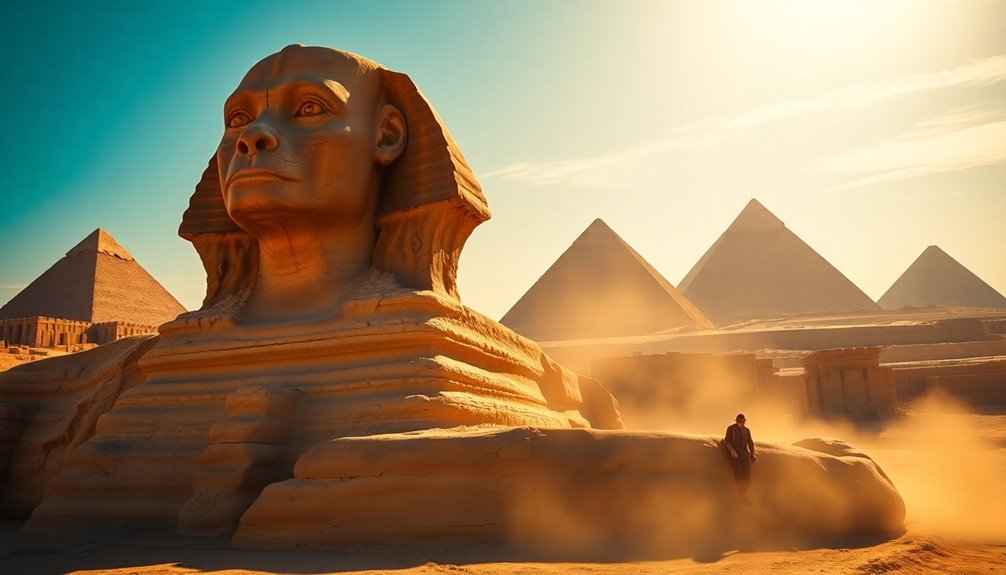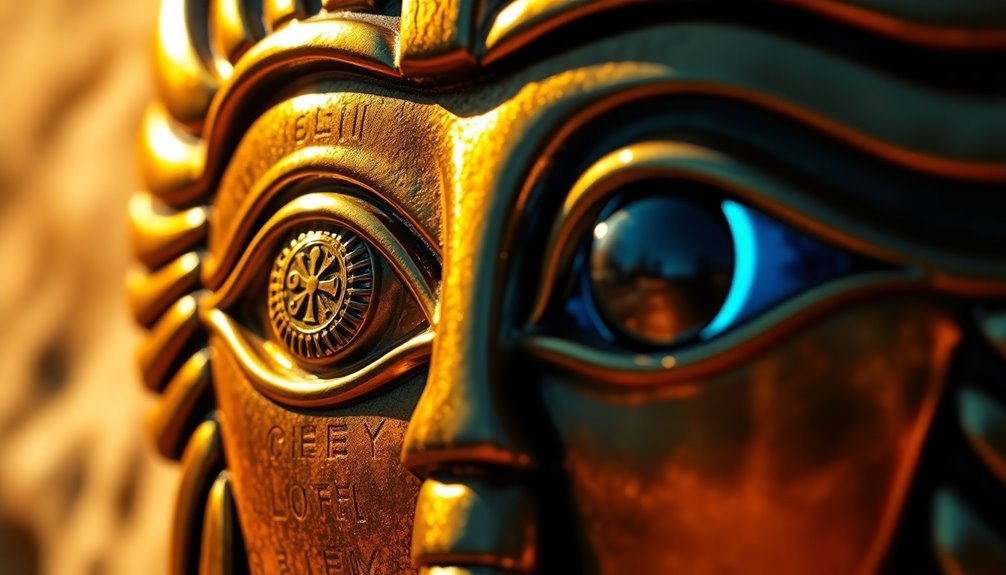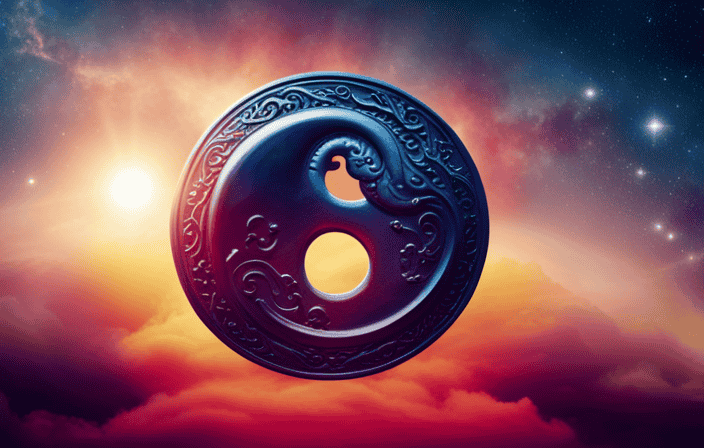The Great Sphinx was built around 2540 B.C. during the reign of Pharaoh Khafre. This impressive monument serves as a symbol of Khafre's power and the advanced engineering of ancient Egypt. It stands 66 feet tall and stretches 240 feet in length, showcasing a blend of human and lion features that represent strength. While there's no direct inscription linking Khafre to the Sphinx, its proximity to his pyramid and facial similarities suggest his involvement. This enigmatic structure continues to captivate historians and visitors alike, hinting at secrets waiting to be uncovered about Egypt's remarkable past.
Key Takeaways
- The Great Sphinx was built around 2540 B.C. during the reign of Pharaoh Khafre in ancient Egypt.
- Construction involved approximately 100 workers and took an estimated three years to complete.
- Khafre is widely accepted as the builder, though alternative theories suggest Pharaoh Djedefre.
- Geological evidence indicates significant erosion, suggesting the Sphinx may have origins dating back to 7000 B.C.
- The Sphinx serves as a cultural symbol, embodying the power and authority of Khafre and ancient Egyptian civilization.
Construction Timeline

The construction timeline of the Great Sphinx of Giza reveals a fascinating glimpse into ancient Egyptian engineering. Built during the reign of Pharaoh Khafre, around 2540 B.C., this monumental sculpture stands as a tribute to the advanced planning and expertise of the Old Kingdom.
Measuring approximately 240 feet in length and 66 feet in height, the Sphinx is one of the largest limestone statues in the world, dominating the Giza plateau.
The construction involved about 100 workers and is estimated to have taken around three years to complete. Scholarly consensus supports the idea that Khafre commissioned this impressive structure, though alternative theories suggest his father, Khufu, or half-brother, Djedefre, could have been responsible.
The alignment of the Sphinx with the rising sun and its architectural features exemplify the sophisticated techniques employed during Egypt's 4th Dynasty. Additionally, the enduring nature of the Sphinx reflects the idea of soulmates and destiny in the cultural beliefs of ancient Egypt, symbolizing a connection between the past and future.
Understanding the construction timeline of the Great Sphinx not only highlights the remarkable achievements of ancient civilizations but also invites you to ponder the dedication and skill that went into creating this enduring symbol of power and mystery.
Pharaoh Khafre's Role
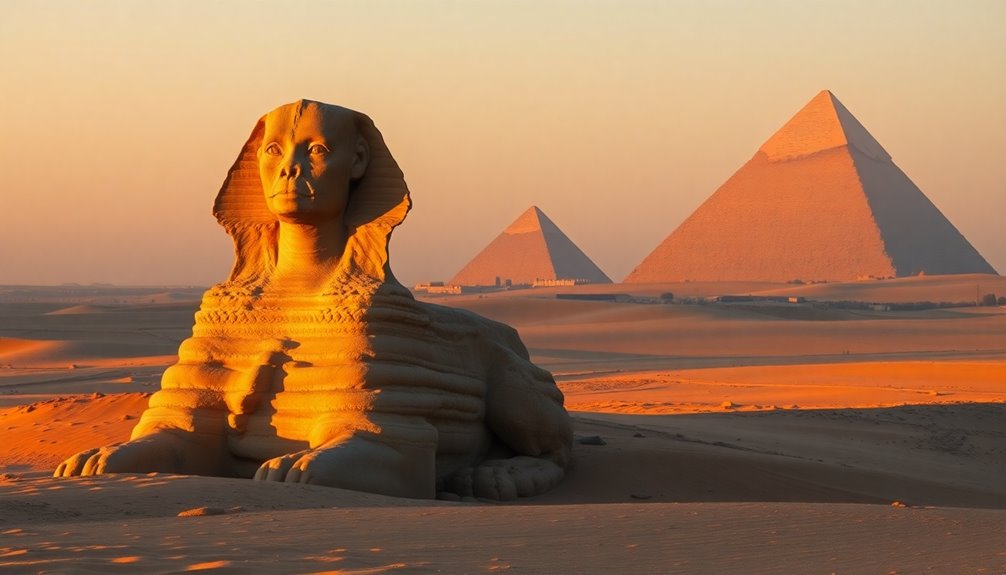
Pharaoh Khafre's reign marked a significant era in ancient Egypt, where his dynastic influence shaped monumental architecture.
You can see this impact in the Great Sphinx, which not only showcases innovative design but also symbolizes the power and authority Khafre wielded.
As we explore his role, it's essential to contemplate how these elements reflect his legacy.
Khafre's Dynastic Influence
During the reign of Khafre, the Fourth Dynasty of Egypt saw the remarkable construction of the Great Sphinx, a symbol of his power and authority. This stunning monument, built from local limestone, measures approximately 240 feet long and 66 feet high, highlighting the resources and organizational capabilities of Khafre's dynasty. The Sphinx's face is believed to represent Khafre himself, creating a direct connection between the pharaoh and the monument.
Here's a quick look at Khafre's contributions:
| Feature | Details | Significance |
|---|---|---|
| Monument | Great Sphinx | Embodies Pharaoh's power |
| Material | Limestone | Reflects local resources |
| Relation to Pyramid | Part of Khafre's complex | Symbolizes dynastic legacy |
Khafre's influence extends beyond just the Sphinx; his pyramid at Giza further solidified his status as a powerful ruler in ancient Egypt. Although no inscriptions directly link Khafre to the Sphinx's creation, the architectural and artistic features clearly indicate it was part of his monumental building projects, showcasing the grandeur of his reign.
Architectural Innovations Under Khafre
Under Khafre's reign, architectural innovations flourished, showcasing the remarkable skills of ancient Egyptian artisans. His ambitious projects at Giza, particularly the construction of the Great Sphinx, exemplified his vision and authority as a Pharaoh. The Sphinx, measuring approximately 240 feet long and 66 feet high, was built from limestone quarried from the Giza Plateau, reflecting both advanced stone-carving techniques and the organizational skills of the time.
Key features of Khafre's architectural complex include:
- The Sphinx: A monumental guardian of the afterlife, emphasizing divine association.
- The Second Pyramid: Aligning with the Sphinx, it demonstrated his cohesive vision for the necropolis.
- Megalithic limestone blocks: Showcasing the grandeur and durability of ancient Egyptian architecture.
- Ceremonial temples: Designed for religious rites, reinforcing Khafre's significance in the afterlife.
- Strategic layout: The entire complex was meticulously planned, reflecting the power and resources available under Khafre.
Together, these innovations not only highlighted the pharaoh's authority but also marked a significant achievement in the architectural history of ancient Egypt.
Symbolism of Khafre's Reign
Khafre's reign symbolizes a pivotal era in ancient Egyptian history, marked by the embodiment of divine authority and protection through monumental structures like the Great Sphinx. As you explore the Giza necropolis, the Sphinx stands as a representation of Khafre's divine power and authority, serving as a guardian over the burial grounds of Egypt's elite. Its lion's body and human head reflect the pharaoh's strength and wisdom, reinforcing his essential role in the afterlife.
Khafre's alignment with the rising sun underscores his connection to the sun god Ra, emphasizing themes of resurrection and eternity in ancient Egyptian beliefs. This symbolism is evident in the Sphinx's positioning near Khafre's pyramid, weaving together notions of life, death, and rebirth.
The temples associated with the Sphinx, constructed from megalithic limestone blocks, further illustrate Khafre's dedication to the afterlife, showcasing the spiritual significance of his reign.
During the Old Kingdom, Khafre's reign marked advancements in art and architecture, with the Sphinx's craftsmanship exemplifying the resources and organization of the era. His legacy continues to inspire awe, encapsulating the profound symbolism of divine authority and protection in ancient Egypt.
Theories of Origin
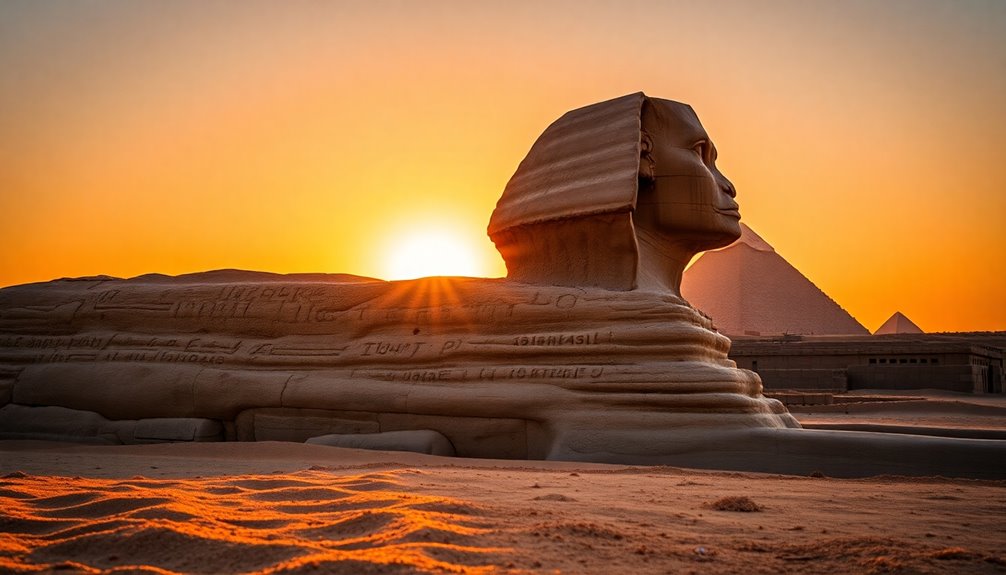
Exploring the theories of origin surrounding the Great Sphinx reveals a complex tapestry of historical perspectives and archaeological debates. The most widely accepted theory attributes its construction to Pharaoh Khafre during Egypt's Fourth Dynasty, around 2603-2578 B.C. This belief is largely based on facial similarities between the Sphinx and Khafre's statues.
However, alternative theories have emerged, suggesting different creators and purposes.
Consider these key points regarding the Sphinx's origin:
- Pharaoh Djedefre: Some propose this son of Khufu as the builder, with the Sphinx as a guardian of his pyramid complex.
- Geological evidence: Significant erosion patterns indicate the Sphinx may predate ancient Egyptian civilization, possibly dating back 9,000 years.
- Dream Stela: The inscription from Thutmose IV suggests cultural importance during the New Kingdom, but it doesn't definitively link Khafre to its construction.
- Alternative theories: Some fringe ideas propose an advanced civilization may have built the Sphinx, despite lacking archaeological support.
- Cultural significance: Regardless of its origins, the Sphinx has maintained an enduring legacy throughout history, enchanting those who encounter it.
Historical Significance
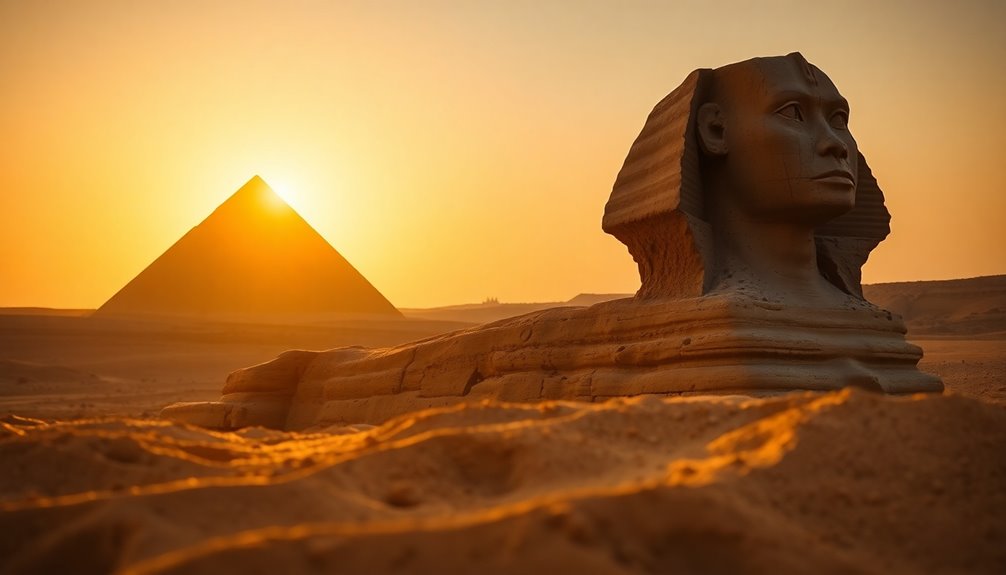
The Great Sphinx of Giza stands as a powerful symbol of Pharaoh Khafre's legacy and ancient Egyptian civilization.
Its monumental presence not only reflects the pharaoh's divine authority but also ties deeply into the culture and beliefs of the time.
As you explore its historical significance, you'll see how it embodies the artistic and spiritual achievements of an entire era.
Pharaoh Khafre's Legacy
While many ancient pharaohs left their mark on history, few achieved the monumental legacy of Pharaoh Khafre, whose reign from around 2575 to 2465 B.C. is prominently remembered for the Great Sphinx.
This iconic statue, carved from limestone, not only showcases the advanced architectural achievements of his era but also symbolizes Khafre's connection to the divine.
Khafre's legacy encompasses several significant aspects:
- The Great Sphinx, a demonstration of his power.
- His pyramid, part of a larger complex that highlights strategic planning.
- The facial features of the Sphinx, believed to resemble Khafre.
- Mortuary temples that reflect his divine status.
- The artistic flourishes that adorned the Sphinx, showcasing the era's craftsmanship.
These elements collectively underscore how Khafre's reign was marked by monumental achievements that resonated through ancient history.
His pyramid stands in close proximity to the Great Pyramid of Khufu, linking father and son in a lineage of power.
As you explore the Sphinx, you're not just witnessing a statue; you're engaging with a rich narrative of legacy, artistry, and the enduring significance of Pharaoh Khafre in ancient Egyptian culture.
Symbol of Ancient Egypt
Majesty and mystery envelop the Great Sphinx of Giza, a timeless symbol of ancient Egyptian civilization. Built around 2540 B.C. during Egypt's Old Kingdom, this monumental sculpture showcases the architectural prowess of the era. Standing at an impressive 240 feet long and 66 feet high, the Sphinx embodies the fusion of human and lion features, representing both power and strength.
Closely associated with Pharaoh Khafre, who likely commissioned its construction, the Great Sphinx symbolizes his divine authority and connection to the gods. As a guardian of the Giza necropolis, it reflects the spiritual beliefs of ancient Egyptians, who offered tributes hoping for favorable harvests.
Over the centuries, the cultural significance of the Sphinx has evolved dramatically. Today, it stands not only as an object of historical significance but also as a symbol of national pride. Millions of tourists flock to witness its grandeur, marveling at the artistry and mystery surrounding its origins.
The Great Sphinx continues to captivate people, serving as a potent reminder of ancient Egypt's enduring legacy and the powerful rulers who shaped its history.
Archaeological Evidence
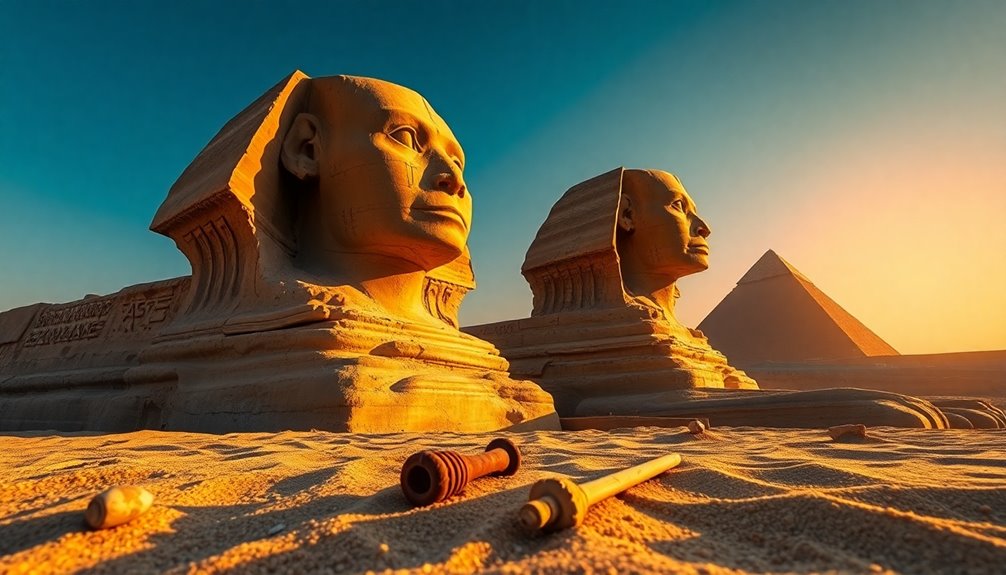
Around 2500 B.C., the Great Sphinx of Giza emerged as a monumental tribute to ancient Egyptian craftsmanship, primarily attributed to Pharaoh Khafre. This stunning structure, carved from a single piece of limestone, showcases the skill and dedication of the workers involved in its construction.
Archaeological evidence supports the connection between Khafre and the Sphinx. Key findings include:
- The proximity of the Sphinx to Khafre's pyramid, suggesting a direct association.
- Facial similarities between the Sphinx and Khafre's statues, reinforcing the attribution.
- The Dream Stela of Thutmose IV, indicating the Sphinx was revered during the New Kingdom.
- The estimation of around 100 workers contributing to the Sphinx's construction over three years.
- Erosion patterns that lead some to propose an alternative dating of the Sphinx, potentially back to 7000 B.C.
Excavations in the 19th and 20th centuries have further revealed insights into the construction techniques of ancient Egyptians.
As you explore the Sphinx's history, you'll uncover layers of evidence that deepen your understanding of its significance and the civilization that built it.
Cultural Impact
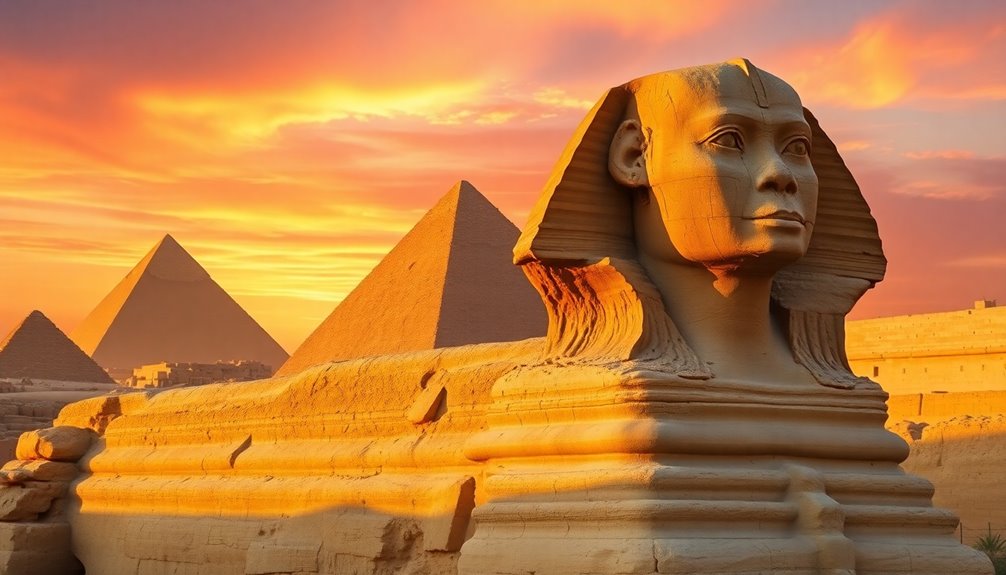
The Great Sphinx of Giza stands as an iconic emblem of ancient Egyptian culture, enchanting millions of visitors each year. Its cultural impact stretches far beyond its physical presence, reflecting the evolution of perceptions over centuries. Initially revered as a guardian, the Sphinx faced neglect before experiencing rediscovery, mirroring changing attitudes toward ancient practices.
The Sphinx showcases remarkable architectural achievements and embodies the fusion of human and animal forms, representing the divine power associated with the Pharaohs like Khafre. This unique blend has solidified its place in the hearts of many.
| Aspect | Description |
|---|---|
| Historical Significance | A symbol of ancient Egyptian civilization |
| Tourism | Attracts millions annually, driving local economy |
| Egyptology | Sparks scholarly interest and research |
| Cultural Fusion | Represents the blend of humanity and divinity |
European fascination with the Sphinx surged during the 12th and 13th centuries, considerably influencing the field of Egyptology. This fascination continues to shape modern interpretations of ancient Egyptian civilization, ensuring that the Sphinx remains a central figure in discussions about its cultural impact.
Frequently Asked Questions
When Was the Sphinx Built and by Whom?
You might find it fascinating that the Great Sphinx of Giza is commonly attributed to Pharaoh Khafre, built around 2540 B.C.
However, there's no definitive evidence linking him directly to the statue. Measuring about 240 feet long and 66 feet high, it symbolizes strength and wisdom.
Some researchers argue it could be much older, potentially dating back to 9,000 years, due to erosion patterns suggesting significant rainfall during its construction.
Why Was the Great Sphinx of Giza Built Blowing up History?
The Great Sphinx of Giza was built to symbolize power and protection, guarding the Giza necropolis.
You can see it as a fusion of human intellect and animal strength, embodying the pharaoh's divine authority. Its construction not only showcased advanced techniques of the time but also represented ancient Egyptian beliefs in the afterlife and the sun gods.
This monumental sculpture reflects a pivotal moment in history, influencing art, culture, and architecture for centuries.
Why Did Khafre Build the Sphinx?
Did you know the Great Sphinx of Giza stands 66 feet tall?
Khafre built the Sphinx as a guardian for his necropolis, symbolizing strength and wisdom. Its lion-human form showcases his divine connection to the sun god Ra.
What Fell off the Great Sphinx in 1988?
In 1988, a significant portion of the Great Sphinx's right ear fell off, raising alarms about its structural integrity.
You'd find that the collapse resulted from a mix of natural weathering and previous restoration attempts that weakened the stone.
Following this, restoration efforts kicked in, using modern materials to reinforce the Sphinx's ear and tackle erosion.
This incident really underscored the ongoing challenges in preserving such an ancient monument.
Conclusion
So, next time you admire the Sphinx, remember it's not just a giant cat lounging in the desert; it's a puzzle wrapped in a riddle that even experts can't agree on. You might think you know who built it, but isn't it ironic that this ancient wonder still keeps its secrets? Whether it was Khafre or someone else, you'll never know for sure—and that's precisely what makes it all the more fascinating.
